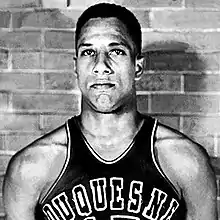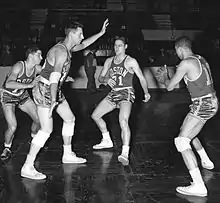 | |
| Personal information | |
|---|---|
| Born | September 29, 1926 Pittsburgh, Pennsylvania, U.S. |
| Died | February 5, 1984 (aged 57) Pittsburgh, Pennsylvania, U.S. |
| Listed height | 6 ft 5 in (1.96 m) |
| Listed weight | 208 lb (94 kg) |
| Career information | |
| High school | Westinghouse (Pittsburgh, Pennsylvania) |
| College |
|
| NBA draft | 1950: 2nd round, 14th overall pick |
| Selected by the Boston Celtics | |
| Playing career | 1950–1956 |
| Position | Small forward / shooting guard |
| Number | 11, 15, 6 |
| Career history | |
| 1950–1954 | Boston Celtics |
| 1954–1956 | Milwaukee / St. Louis Hawks |
| 1956 | Fort Wayne Pistons |
| Career highlights and awards | |
| |
| Career statistics | |
| Points | 2,725 (6.7 ppg) |
| Rebounds | 2,431 (5.9 rpg) |
| Assists | 734 (1.8 apg) |
| Stats at NBA.com | |
| Stats at Basketball-Reference.com | |
| Basketball Hall of Fame as player | |
Charles Henry Cooper (September 29, 1926 – February 5, 1984) was an American professional basketball player.
Cooper played college basketball for Duquesne University and was named an All-American. He was the first African-American to play in a college basketball game south of the Mason-Dixon line. In 1950, Cooper and two others--Nat "Sweetwater" Clifton and Earl Lloyd--became the first African-American players in the National Basketball Association (NBA).[1] Cooper was also the first African-American to be drafted by an NBA team; he was chosen by the Boston Celtics with the first pick of the second round of the 1950 NBA Draft.[1] In a six-season NBA career, Cooper played for the Celtics, the Milwaukee/St. Louis Hawks, and the Fort Wayne Pistons, averaging 6.7 points and 5.9 rebounds per game.
Cooper was inducted into the Naismith Memorial Basketball Hall of Fame on September 9, 2019.[2]
Early life and college career
Cooper was born in Pittsburgh, Pennsylvania, the son of Daniel and Emma Cooper.[3] Daniel was a mailman, and Emma was a school teacher. He attended Pittsburgh's Westinghouse High School and graduated in 1944.[4] For his senior year, he averaged more than 13 points per game and was an All-City first-team center. He then attended and played a semester of basketball for West Virginia State College (now University) before being drafted to serve in the United States Navy in the final stages of World War II.[3]
Following his service, he enrolled at Duquesne University where he was an All-American, started all four years, and set the school record for total points with 990 in four seasons. During his time at Duquesne, the team had a 78–19 record and was invited to the then-prestigious National Invitation Tournament twice. He was a captain for the 1949–50 team, which was the first team from the university to be nationally ranked all season, finishing with a 23–6 record and ranked sixth nationally.[5] He was the first African American to participate in a college basketball game south of the Mason–Dixon line.[6]
NBA career

Coming out of college in 1950, Cooper signed with the Harlem Globetrotters. On April 25, 1950, he became the first African American drafted into the NBA when the Boston Celtics chose him with the 14th overall pick.[7] Cooper was drafted by Celtics' owner Walter A. Brown, coached by the legendary Red Auerbach and a teammate of the great Bob Cousy. When officials from other teams learned of Boston's interest in Cooper, they suggested he should not be drafted because he was black; however, Brown's famous quote was: "I don't give a damn if he's striped, plaid or polka dot. Boston takes Charles Cooper of Duquesne." Cooper made his NBA debut on November 1, 1950, against the Fort Wayne Pistons.[4]
Cooper played four years with the Celtics,[3] then was traded to the Milwaukee Hawks before ending his career as a member of the Ft. Wayne Pistons. After that, he spent a year playing for the Harlem Magicians, before injuring his back in a car crash and leaving basketball. During his NBA career, Cooper played a total of 409 games, scored 2,725 points for an average of 6.66 points per game, had 2,431 rebounds for an average of 5.9 per game, and had 733 assists for an average of 1.79 per game. As some statistics were not kept during that time, it is not known how many blocked shots, steals, or turnovers he had during his career.
After the NBA
After his NBA career, Cooper graduated with a Master of Social Work from the University of Minnesota in 1960. He was married twice; first in 1951, and then in 1957 to Irva Lee (with whom he had four children). He worked to improve his hometown of Pittsburgh, serving on the Pittsburgh school board, and was appointed the director of parks and recreation for the city, becoming the first Black department head. He also helped the Pittsburgh National Bank's affirmative action program as an urban affairs officer[8] until he died in Pittsburgh at the age of 57 on February 5, 1984,[3] of liver cancer at Forbes Hospice.[6]
NBA career statistics
| GP | Games played | GS | Games started | MPG | Minutes per game |
| FG% | Field goal percentage | 3P% | 3-point field goal percentage | FT% | Free throw percentage |
| RPG | Rebounds per game | APG | Assists per game | SPG | Steals per game |
| BPG | Blocks per game | PPG | Points per game | Bold | Career high |
Regular season
| Year | Team | GP | MPG | FG% | FT% | RPG | APG | PPG |
|---|---|---|---|---|---|---|---|---|
| 1950–51 | Boston | 66 | – | .344 | .753 | 8.5 | 2.6 | 9.3 |
| 1951–52 | Boston | 66 | 29.9 | .361 | .741 | 7.6 | 2.0 | 8.2 |
| 1952–53 | Boston | 70 | 28.5 | .337 | .758 | 6.3 | 1.6 | 6.5 |
| 1953–54 | Boston | 70 | 15.7 | .299 | .672 | 4.3 | 1.1 | 3.3 |
| 1954–55 | Milwaukee | 70 | 25.0 | .339 | .751 | 5.5 | 2.2 | 8.2 |
| 1955–56 | St. Louis | 35 | 16.4 | .337 | .738 | 3.9 | 1.7 | 5.1 |
| 1955–56 | Fort Wayne | 32 | 17.8 | .316 | .776 | 3.2 | 0.9 | 3.9 |
| Career | 409 | 23.2 | .339 | .743 | 5.9 | 1.8 | 6.7 | |
Playoffs
| Year | Team | GP | MPG | FG% | FT% | RPG | APG | PPG |
|---|---|---|---|---|---|---|---|---|
| 1951 | Boston | 2 | – | .339 | .400 | 6.5 | 1.5 | 5.0 |
| 1952 | Boston | 3 | 42.7 | .320 | .895 | 5.3 | 1.3 | 11.0 |
| 1953 | Boston | 6 | 32.5 | .396 | .815 | 6.5 | 2.3 | 10.0 |
| 1954 | Boston | 6 | 18.0 | .500 | .727 | 5.2 | 0.7 | 4.0 |
| 1956 | Fort Wayne | 9 | 6.6 | .192 | .667 | 1.9 | 0.2 | 1.3 |
| Career | 26 | 20.4 | .346 | .785 | 4.5 | 1.0 | 5.3 | |
See also
References
- 1 2 "1950–51 Season Overview". NBA's Color Line is Broken. NBA.com. Archived from the original on March 20, 2015. Retrieved March 9, 2013.
- ↑ "Divac, Sikma, Moncrief headline Hall of Fame Class of 2019". National Basketball Association. April 6, 2019.
- 1 2 3 4 "Chuck Cooper, one of the NBA's first black players". African American Registry. Archived from the original on May 18, 2015. Retrieved May 12, 2015.
- 1 2 Dave Howell, "Six Who Paved the Way", NBA.com.
- ↑ "Duquesne University Official Athletic Site". Archived from the original on May 18, 2015.
- 1 2 "Chuck Cooper dead at 57; Duquesne basketball great", Pittsburgh Post-Gazette, February 6, 1984.
- ↑ "1950 NBA Draft".
- ↑ "Chuck Cooper, NBA player". New York Times. February 7, 1984. Retrieved May 12, 2015.
External links
- Chuck Cooper's career NBA Stats from databasketball.com
- Biography at answers.com
- Chuck Cooper at Find a Grave
- Phil Axelrod, "Duquesne honors legacy of Chuck Cooper" Archived October 19, 2012, at the Wayback Machine, Pittsburgh Post-Gazette, December 6, 2009.